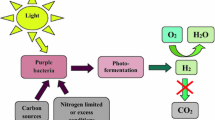Abstract
In order to examine the mediatory role of proton motive force (∆p) or proton ATPase in H2 production by Rhodobacter sphaeroides, ∆p was determined under anaerobic conditions in the dark, and the ATPase activity has been studied in R. sphaeroides strain A-10, isolated from Arzni mineral springs in Armenia. Membrane potential (∆φ) was measured from the distribution of tetraphenylphosphonium cation; pH gradient (∆pH) was the difference between the external and cytoplasmic pH values, and the latter was measured by 9-aminoacridine (9-AA) fluorescence changes. At pH 7.5, ∆φ was of −94 mV and the reversed ∆pH was +30 mV, resulting in ∆p of −64 mV. The addition of N,N′-dicyclohexylcarbodiimide (DCCD), the F0F1–ATPase inhibitor, was not affect ∆φ. It was shown that ∆φ varies nearly linearly with ΔpH, ∆φ increased from −57.1 mV at pH 6.0 to −103.8 mV at pH 8.0; it was compensated at high external pH by a reversed ∆pH, resulting in a low ∆p under anaerobic-dark conditions. Intracellular ATP concentrations and energetic charge (EC) were measured to evaluate a metabolism activity of R. sphaeroides.



Similar content being viewed by others
References
Atkinson DE (1971) Adenine nucleotides as stoichiometric coupling agents in metabolism and as regulatory modifiers: the adenylate energy charge. In: Vogel HJ (ed) Metabolic regulation. Academic Press Inc., New York, pp 1–21
Bagramyan K, Mnatsakanyan N, Poladyan A et al (2002) The roles of hydrogenases 3 and 4, and the F0F1-ATPase, in H2 production by Escherichia coli at alkaline and acidic pH. FEBS Lett 516:172–178
Blair DF (2003) Flagellar movement driven by proton translocation. FEBS Lett 545:86–95
Boyer PD (1988) Bioenergetic coupling to protonmotive force: should we be considering hydronium ion coordination and not group protonation? Trends Biochem Sci 13(1):5–7
Feniouk BA, Suzuki T, Yoshida M (2007) Regulatory interplay between proton motive force, ADP, phosphate, and subunit β in bacterial ATP synthase. J Biol Chem 282:764–772
Gabrielyan L, Mnatsakanyan N, Trchounian A (2006) Molecular hydrogen production by Rhodobacter sphaeroides: phenomenon, redox potential and proton-coupled processes. Biochim Biophys Acta 14:269–270
Gabrielyan L, Trchounian A (2009) Relationship between molecular hydrogen production, proton transport and the F0F1-ATPase activity in Rhodobacter sphaeroides strains from mineral springs. Int J Hydrogen Energy 34:2567–2572
Grinus LL, Daugelavichus RJ, Alkmavichus GA (1980) Study of the membrane potential of Bacillus subtilis and Escherichia coli cells by the penetration ion method. Biokhimiia 45:1609–1618 (in Russian)
Hellingwerf KJ, Konings WN (1981) Proton motive force and secondary transport. Antonie van Leeuwenhoek 47:579–580
Jones OTG (1997) In: Haddock BA, Hamilton WA (eds) Microbial Energetics. Cambridge University Press, Cambridge, pp 151–183
Kapdan IK, Kargi F (2006) Bio-hydrogen production from waste materials. J Enzyme Microb Technol 38:569–582
Kars G, Gündüz U, Yücel M et al (2009) Evaluation of hydrogen production by Rhodobacter sphaeroides O.U.001 and its hupSL deficient mutant using acetate and malate as carbon sources. Int J Hydrogen Energy 34:2184–2190
Khatipov E, Miyake M, Miyake J et al (1998) Accumulation of poly-β-hydroxybutyrate by Rhodobacter sphaeroides on various carbon and nitrogen substrates. FEMS Microbiol Lett 162:39–45
Kim MS, Baek JS, Lee JK (2006) Comparison of H2 accumulation by Rhodobacter sphaeroides KD131 and its uptake hydrogenase and PHB synthase deficient mutant. Int J Hydrogen Energy 31:121–127
Kobayashi H, Suzuki T, Kinoshita N et al (1984) Amplification of the Streptococcus faecalis proton-translocating ATPase by a decrease in cytoplasmic pH. J Bacteriol 158:1157–1160
Lakin GF (1992) Biometry. Vishaya shcola, Moscow (in Russian)
Levin DB, Pitt L, Love M (2004) Biohydrogen production: prospects and limitations to practical application. Int J Hydrogen Energy 29:173–185
Lowry OH, Rosebrough NJ, Farr AL et al (1953) Protein measurement with the folin phenol reagent. J Biol Chem 193:265–275
Michels AM, Konings WN (1978) The electrochemical proton gradient generated by light in membrane vesicles and chromatophores from Rhodopseudomonas sphaeroides. Eur J Biochem 85:147–155
Ooshima H, Takakuwa S, Katsuda T et al (1998) Production of hydrogen by a hydrogenase-deficient mutant of Rhodobacter capsulatus. J Ferment Bioengin 85:470–475
Ormerod JG, Ormerod KS, Gest H (1961) Light-dependent utilization of organic compounds and photoproduction of molecular hydrogen by photosynthetic bacteria, relationship with nitrogen metabolism. Arch Biochem Biophys 94:449–463
Paronyan AKh (2003) Ecology, biological peculiarities of phototrophic bacteria of Armenia and perspectives of their application. DSc thesis. Abovyan, Armenia (in Russian)
Puchkov EO, Bulatov IS, Zimchenko VP (1983) Investigation of intracellular pH in Escherichia coli by 9-aminoacridine fluorescence measurements. FEMS Microbiol Lett 20:41–45
Reith JH, Wijffels RH, Barten H (2003) Bio-methane & Bio-hydrogen: Status and perspectives of biological methane and hydrogen production. Novem, Netherlands
Setty OH, Hendler RW, Shrager RI (1983) Simultaneous measurements of proton motive force, delta pH, membrane potential, and H+/O ratios in intact Escherichia coli. Biophys J 43:371–381
Taussky HH, Shorr E (1953) A microcolorimetric method for the determination of inorganic phosphorus. J Biol Chem 202:675–685
Trchounian AA, Vassilian AV (1994) Relationship between the F0F1-ATPase and K+transport system within the membrane the anaerobically growth Escherichia coli. N, N′-Dicyclohexylcarbodiimide-sensitive ATPase activity in mutants with defects in K+-transport. J Bioenerg Biomembr 26:563–571
Zakharova NB, Rubin VI (1980) Thin layer chromatography of erythrocyte nucleotides on Silufol plates. Lab Delo 12:735–738 (in Russian)
Acknowledgments
The author thank Prof. P. Kazaryan (Eolyan Hematology Center, Yerevan) for his help in ANP determination and valuable comments. This study was supported by the Armenian National Science and Education Fund, USA (ANSEF NS-Biotechnology-1668) and by the Research Grant from the Ministry of Education and Science of Armenia (#1012-2008).
Author information
Authors and Affiliations
Corresponding author
Rights and permissions
About this article
Cite this article
Hakobyan, L., Gabrielyan, L. & Trchounian, A. Proton Motive Force in Rhodobacter sphaeroides Under Anaerobic Conditions in the Dark. Curr Microbiol 62, 415–419 (2011). https://doi.org/10.1007/s00284-010-9723-1
Received:
Accepted:
Published:
Issue Date:
DOI: https://doi.org/10.1007/s00284-010-9723-1




